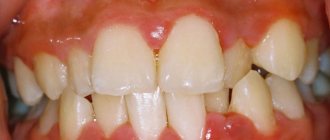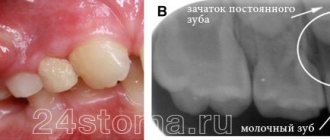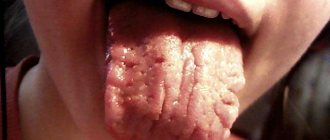What is epulis?
Epulis is a formation on the gum in the form of a tumor. It has synonymous names: supragingival, epulid, giant cell granuloma. Most often, epulis occurs on the alveolar jaw process, in the area of small molars; There are cases of occurrence on the body of the jaw (usually the lower one). Occurs both in adults (several times more often in women) and in children
What it is?
This unusual term refers to a tumor of fibrous tissue of a benign nature . Despite its benign origin, this type of neoplasm often behaves quite aggressively. In particular, one type of epulis causes complete or partial destruction of not only the fibrous tissue by which the teeth are attached to their alveoli, but even the bone. Moreover, the degree of destruction is such that in severe cases it is necessary to completely (!) remove the upper or lower jaw. You understand that an animal with such an injury definitely becomes disabled, since it no longer has a chance for a normal life.
Important! There is still no reliable information about the exact causes of the disease, and therefore even prevention of this disease is impossible. The genetic and viral theories have the most supporters.
Interestingly, it is not uncommon for practicing veterinarians to encounter gum pathologies during medical examinations of animals. But there are quite a lot of aspects to their treatment, it all depends on the specific case and the condition of the sick pet. So, in some cases it is necessary to trim the gums, in others it becomes necessary to “extract” a tooth, sometimes all teeth have to be removed ... Moreover, you need to decide how much theoretically healthy tissue needs to be left along the edge of the gums. Finally, after all these issues have been resolved, the question of the degree of operability of the tumor and the need to use radiation/chemical therapy arises. Thus, epulis is a rather “complex” disease that requires a balanced and differentiated approach to treatment.
Causes: why does a tumor form?
Epulis occurs under the influence of the following factors:
- Injury to the gums through: an overhanging filling;
- edges of a decayed tooth;
- tartar;
- burn;
- bruise;
- poor quality prosthesis.
Prevention
To minimize the likelihood of epulis formation, you need to follow simple preventive measures:
- Timely sanitization of the oral cavity. Every six months it is necessary to undergo a preventive examination of teeth and gums, as well as professional oral hygiene in a dental office. Professional hygiene will help prevent the growth of caries and the formation of hard dental deposits that can injure the gums. If an oral disease is detected, be it a tooth or gum, it must be treated immediately.
- Prevention of periodontal injury. If soft tissues are systematically injured by a filling, prosthesis or orthodontic structure, you should immediately seek help from a doctor.
Symptoms and signs: what does epulis look like?
In general, epulids in diameter can reach from several mm to 3 cm or more. The color of the supragingival can be reddish-brown, brown, bluish , and also match the color of the gums . Often, ulcers may appear on the surface of a giant cell granuloma, which is most often caused by permanent trauma (sharp edge of a tooth, denture).
The shape of epulid is mushroom-shaped. The formation is located on a stalk, sometimes on a broad base. When pressed, it may move slightly. Epulis can be both soft and hard to the touch. Sometimes the teeth in the area of formation are mobile and slightly displaced.
There are two clinical forms of epulis: benign and malignant. Each of them has its own symptoms. Signs of a benign epulis tumor are:
- Slow growth;
- Diameter up to 2 cm;
- Usually asymptomatic course of the disease.
Malignant supragingival tissue is characterized by:
- Swelling of the gums;
- Rapid growth;
- Soreness;
- Destruction of dental root canals in tissues close to inflammation.
Why is epulis dangerous?
Growing to a significant size, epulis causes discomfort: it interferes with closing the jaws and impairs the clarity of speech. In addition, a growth in the smile area is an aesthetic defect noticeable to others. But this is not a complete list of the unpleasant consequences that epulis leads to. The neoplasm can cause serious and difficult to correct disorders:
- mobility of adjacent teeth develops;
- if the epulis is mechanically damaged, there is a risk of tissue infection by pathogenic bacteria or fungi;
- due to the inability to fully chew food, disruptions in the functioning of the digestive system occur;
- giant cell epulis is capable of developing into a malignant form [1, 3].
Warning signs include the appearance of darker spots on the surface, an unpleasant odor or taste in the mouth, and soreness in the jaw.
N. M. Mustafaev, Ph.D. honey. Sciences, dental surgeon [3]
Diagnostics
The diagnosis is made based on examination by a specialist and histological examination. A differential diagnostic method is used to exclude the presence of hypertrophic gingivitis in the patient. It has similar symptoms to epulis. An x-ray is also used for diagnosis, where, with epulide, rarefaction and destruction of bone tissue due to inflammation are observed.
How to treat?
Gum treatment should begin as soon as you notice growth. In most cases, you have to resort to surgical intervention, since drug therapy in this case does not have a positive result. The growth is excised under general or local anesthesia. After removal of the epulis, it is recommended to send the biomaterial for histological examination to exclude the malignant nature of the neoplasm.
Next, the doctor prescribes antibiotics and anti-inflammatory drugs to avoid possible complications. For speedy healing, wound healing and antiseptic agents may be prescribed.
Classification
There are several types of epulis. Each of them has its own number in ICD-10 (International Classification of Diseases, 10th revision).
Fibrous (K06.82 - benign neoplasms):
Location area: vestibular side of the gum;
- Round or oval shape;
- Slow growth;
- Surface smooth/lumpy surface;
- Doesn't bleed;
- Wide base;
- Thick consistency;
- Light pink (to match the gum color).
Angiomatous:
- Location area: neck of the tooth;
Giant cell (K06.81 - other specified changes in the gums):
- Location area: alveolar part;
Treatment methods, how the tumor is removed
Surgical removal
Treatment with epulid is carried out by removing the tumor. An incision is made at a short distance from the epulis, after which it is removed along with the periosteum. If surgery is performed on a giant cell granuloma, an area of bone tissue is also removed. The procedure is carried out using a bur or cutter. If the formation is more than 1 cm, then removal is often carried out under anesthesia with pharyngeal tamponade. The operated area is covered with iodoform gauze. Teeth are removed only when there is great mobility and root exposure. The dentist is the doctor you should contact if you have symptoms of epulis.
After stopping the bleeding, cauterization with alcohol, piocide, thermocautery, or an electrical regulator may be suggested. Treatment of angiomatous epulis can be carried out through sclerotherapy (urethane-quinidine mixture).
Laser treatment
One treatment option is laser removal of the granuloma. The procedure is performed under infiltration anesthesia. Excision of the body of the epulis is performed using a calibrated laser; removal of the body is done with tweezers.
Folk remedies
It is impossible to cure the supragingival tissue with folk remedies (without surgery). Folk remedies will only help in tissue healing. The composition of rinses for quick recovery should be agreed upon with the dentist. Effective recipes:
- Chamomile / sage / eucalyptus / calendula. Two tablespoons of dry plant + a glass of boiling water. Wait until the solution cools slightly. Rinse several times daily.
- A teaspoon of soda + a glass of warm water (prevents suppuration);
- A teaspoon of salt + a glass of hot water. Wait until it cools down (anti-swelling).
Basics of diagnosis
It all starts with an inspection. The breeder can voice the history of the development of epulis, if he noticed it, what are the symptoms, when, presumably, the tumor formed, for what reason (gum injuries, fights with damage to the oral mucosa, etc.).
Of the special research methods, those that allow differentiating a benign neoplasm from a malignant one (cytological and histological examination) are used. In some cases, an x-ray is prescribed to trace the degree of penetration of the epulis inside, changes in the dentition, and indicate the boundaries of the tumor.
A biopsy and examination of a piece of epulis tissue allows the veterinarian to understand the nature of the tumor, the prospects for its growth and the preliminary result of treatment, which of the therapeutic tactics will be most effective. More often, the true nature of the tumor and an accurate diagnosis are made as a result of histological examination and after removal of the tumor. The analysis itself is carried out by a veterinary morphologist within 2-3 weeks.
[custom_ads_shortcode1]
How does it occur in children?
In babies, epulis may appear during teething. Most often this is an angiomatous type of disease, but others can occur less frequently. It is advisable to contact a specialist as soon as possible to prevent the danger of tumor growth. Epulis must be removed through surgery. Sometimes the angiomatous appearance is treated with sclerotherapy
Treatment of epulis
Treatment of this disease in the initial stages is, first of all, the elimination of any external irritants (removal of tartar, treatment of caries). Repeated prosthetics may be required in cases where epulis was caused by injuries caused by an unsuccessful orthopedic design.
If necessary, injured teeth that cling to the gums with sharp edges are also ground and treated. In the initial stages, the disease can be stopped even after conventional sanitation of the oral cavity, but after it is carried out it is necessary to monitor the dynamics of recovery.
In more severe forms (in particular, with giant cell epulis), surgical intervention is indicated. It is carried out by excising the neoplasm within the boundaries of healthy tissues not affected by it. As for displaced or mobile teeth located next to the epulis, the prognosis for them largely depends on the degree of damage. If teeth become loose enough to be beyond repair, they will have to be removed.
If you do not completely eliminate all the factors that provoked the appearance of epulis, the likelihood of relapse is very high. If risk factors are eliminated, we can talk about a favorable prognosis.
Epulis during pregnancy
Giant cell epulide is most common among pregnant women. Other types of disease are also common in expectant mothers. The body of epulis in pregnant women is subject to accelerated growth due to hormonal changes in the body (occurs for the same reason). Epulis should not be confused with a fistula (a white pimple-like formation with an opening from which white pus flows). In this case, folk remedies will only help speed up healing after excision. There is evidence that after pregnancy, epulis decreases significantly.
Symptoms of epulis in dogs
The disease does not have specific signs, often they are only indirect: the dog develops bad breath, excessive salivation, nasal discharge, the owner notices the appearance of blood in a bowl of water, on toys. The dog may be bothered by something in the mouth area, soreness appears - the animal is reluctant to eat. When the tumor reaches a large size, it begins to “bulge” the cheek or bulge outward. As a result, asymmetry of the muzzle occurs. Also, this could be a completely random find.
FAQ
Epulis and bleeding: normal or not?
Yes, this is the norm . Angiomatous epulis most often bleeds heavily, while giant cell epulis bleeds moderately. If the supragingival body is injured, bleeding may occur.
Can the tumor go away on its own?
No, reverse development is almost impossible. It is necessary to consult a doctor to remove epulid. Most often, experts recommend excision of the tumor.
Can epulis reappear after cauterization?
Yes, relapses are not excluded . If a formation occurs, you should contact your dentist again.
How to distinguish epulis from hypertrophied gingivitis?
With hypertrophied gingivitis, the gums swell and enlarge, acquiring a scarlet color. There is also bleeding of the gums, heavy plaque on the teeth, an unpleasant odor, and discomfort when chewing solid food. With epulis, such changes in the gums do not occur.
Is it possible to place implants if you once had epulis?
Yes, you can.
How is epulis different from gum cancer?
Symptoms and consequences. Signs of gum cancer are:
- Large swelling;
- Whitish lesions;
- Painful sensations when touched;
- Pigmentation of the seal;
- Ulcers and cracks around the formation;
- Heavy bleeding.
Fatalities are extremely rare, but they do happen. Sometimes the signs of gum cancer are blurred, so if swelling occurs, you should consult a doctor. In the early stages, the disease is treated much faster and easier, but an advanced form can lead to many complications.
Will my gums heal after surgery?
Yes, it is overgrown. It is necessary to follow the wearing of the bandage and all the doctor’s recommendations for good healing.
Epulis on the gum under the denture
The reasons for the appearance of lumps under the prosthesis can be:
- Expired prosthesis;
- Improper dental care (lack of hygiene);
- Gum injury;
- Taking strong medications.
Differentiation of epulis types, diagnosis
Today there are three types of the disease. In some ways they are similar, but their other characteristics can differ significantly:
- Fibrous epulis. The most common, “classic” type of the disease. It is characterized by fibrous growths along the edge of the gums.
- "Ossifying" type. It is characterized by a gradual thickening of the tumor, impregnation with mineral salts.
- The most severe type of epulis is acanthomatous. It is precisely characterized by the phenomena that we wrote about below. The pathology causes destruction of bone and fibrous tissue, as a result of which the dog can either become toothless (and this is in the best case, by the way), or remain disabled if the upper/lower jaw is removed.










